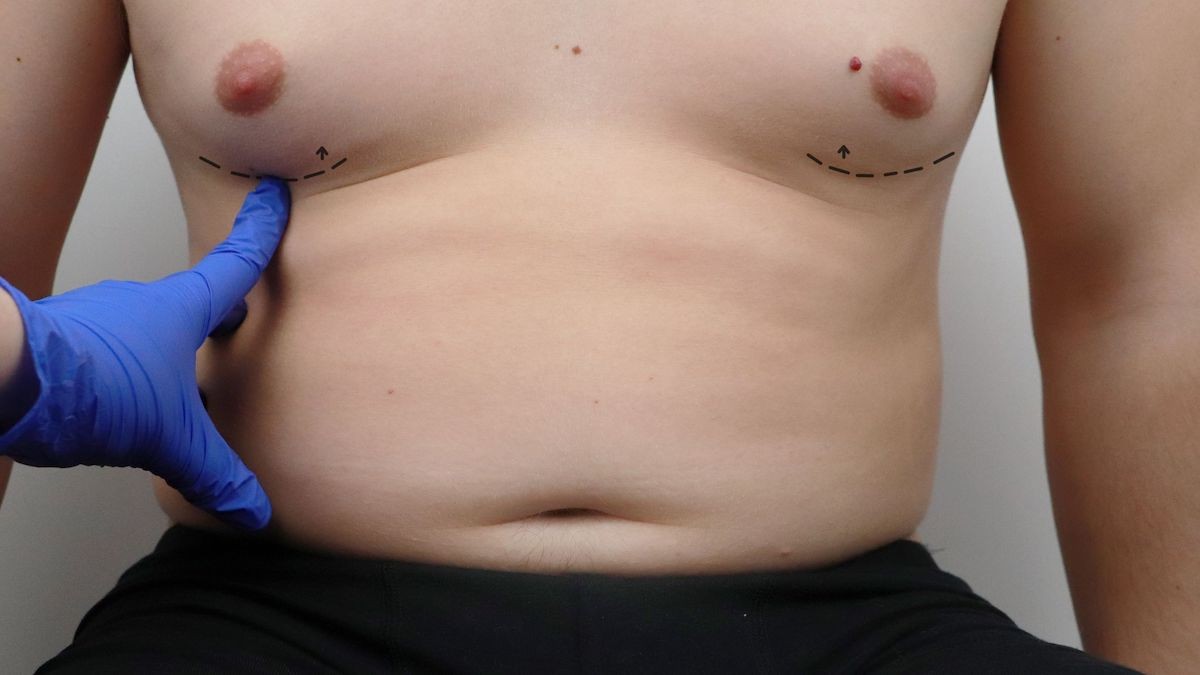Table of Contents
- Causes of Puffy Nipples in Men
- Hormonal Imbalances: Gynecomastia and Testosterone Levels
- Excess Body Fat Affecting Nipple Appearance
- Diseases and Medications That Cause Puffy Nipples
- Lifestyle Choices Impacting Nipple Puffiness
- Dietary Changes for Reducing Puffiness
- Chest Exercises to Reduce Nipple Puffiness
- Back & Shoulder Strengthening Techniques
- Gynecomastia Treatment Options
- FAQs in Relation to Puffy Nipples Men
- Conclusion
Many males may feel uncomfortable or disheartened by the phrase “puffy nipples.” Various factors, including hormonal imbalances, excess body fat, and certain medical conditions or medications often cause puffy nipples in men. In this comprehensive guide on puffy nipples men, we will delve into the causes behind this phenomenon and explore various methods to help reduce puffiness.
We will discuss dietary changes that can positively impact hormone levels and overall health while also shedding light on specific chest exercises designed to target enlarged breast tissue. Furthermore, our focus will extend to back and shoulder strengthening techniques that contribute towards an improved posture – which may alleviate some instances of nipple puffiness.
Lastly, we’ll examine gynecomastia treatment options available for those who suffer from this condition and guide consulting with specialists for proper diagnosis and potential treatments such as testosterone replacement therapy or surgical interventions like liposuction and glandular excision. By understanding the underlying causes of puffy nipples in men and implementing the effective strategies outlined here, one can regain confidence in one’s appearance.
Causes of Puffy Nipples in Men
Don’t let puffy nipples deflate your confidence; hormonal imbalances, excess body fat, certain diseases and medications, and lifestyle choices can all contribute to this issue. Puffy nipples men are treatable.

Hormonal Imbalances: Gynecomastia and Testosterone Levels
When hormones such as estrogen and testosterone are imbalanced, gynecomastia may develop, causing enlargement of the breasts or puffiness in the nipples; this can be due to a variety of causes including age, obesity, organ dysfunction, hormone deficiency/excessiveness and nutritional deficiencies.
Excess Body Fat Affecting Nipple Appearance
Excess body fat can also play a role in puffy nipples men by increasing overall chest size, making your nipples appear puffier; losing weight through dietary changes and regular exercise may help improve the appearance of your chest area.
Diseases and Medications That Cause Puffy Nipples
- Liver cirrhosis, kidney failure, and thyroid disorders can lead to hormonal imbalances that cause puffy nipples.
- Anti-androgens, anabolic steroids, or drugs used in HIV treatment may also contribute to the development of gynecomastia and puffiness around the nipple area.
Lifestyle Choices Impacting Nipple Puffiness
Consuming excessive amounts of alcohol or using recreational drugs like marijuana can negatively affect testosterone production, leading to puffy nipples; poor sleep habits or chronic stress may disrupt hormonal balance, further exacerbating this issue.
Adopting healthier lifestyle habits like reducing alcohol consumption, avoiding drug use, getting adequate sleep, and managing stress through relaxation techniques or counseling can help you maintain balanced hormone levels, which will improve the appearance of your chest area over time.
Dietary Changes for Reducing Puffiness
Reduce puffy nipples by ditching processed foods, sugary sodas, and refined carbs for whole, unprocessed foods like fruits, veggies, lean proteins, and healthy fats from sources like avocados or nuts.
Avoid Unhealthy Fats in Processed Foods
Processed foods contain unhealthy amounts of trans and saturated fats that contribute to excess body fat, so stick to whole foods instead.
Check out this guide to healthy eating for more tips on making better food choices.
Choose Diet Sodas or Water Over Sugary Beverages
Sugary drinks like soda are a significant source of empty calories that lead to weight gain without providing any nutritional benefits.
Opt for healthier beverage options, such as water or unsweetened tea instead of regular soda to cut down on unnecessary calorie consumption while staying hydrated.
Limit Refined Carbohydrates
Refined carbs cause blood sugar spikes followed by crashes leading to increased hunger levels and overeating.
Instead, consume complex carbohydrates found in whole grains like brown rice and quinoa along with legumes and starchy vegetables for sustained energy release without drastic blood sugar fluctuations.
The Harvard School of Public Health offers a comprehensive guide on understanding carbohydrates and their impact on your health.
Consuming these food items can not only reduce the look of swollen nipples, but also have a positive effect on general wellbeing, vigor and weight regulation.
Remember that consistency is key when making lifestyle adjustments; be patient with yourself as you work towards achieving your goals.
Chest Exercises to Reduce Nipple Puffiness
Strengthening chest muscles can help minimize puffy nipples, and combining these exercises with back and shoulder workouts will provide a balanced physique.
Push-ups for Overall Chest Strength
Varying hand positions during push-ups targets different parts of the chest muscles, and adding push-up bars or elevating feet increases difficulty.
Bench Press for Compound Movement
Incorporating flat and incline bench presses engages multiple muscle groups, and using dumbbells allows for greater range of motion and individual arm control.
Dumbbell Flyes for Outer Chest Development
Isolate the outer portion of chest muscles near the nipple area with dumbbell flyes, and focus on proper form by slowly lowering weights in a wide arc motion.
Consistently incorporating these exercises into your workout routine will improve the appearance of puffy nipples, posture, and overall upper body strength.
Back & Shoulder Strengthening Techniques
Focusing on back and shoulder strengthening alongside chest workouts provides better posture support while minimizing puffiness around your nipples.
Include pulling movements like rows or pull-ups for even distribution across upper-body muscle groups.
Pull-up Variations Targeting Multiple Back Muscles Simultaneously
Pull-up variations engage multiple back muscles simultaneously, reducing nipple puffiness.
Vary hand positions (wide grip, close grip, chin-ups) to target muscles from different angles.
Add weight with a weighted vest or belt to increase difficulty.
Row Exercises Engaging Lats Along With Other Stabilizing Muscles
Row exercises, such as bent-over rows or seated cable rows, engage lats and other stabilizing muscles in the shoulders and core.
Alternate between barbell rows for heavier loads and dumbbell rows for an increased range of motion.
Overhead Presses Emphasizing Deltoid Development
Overhead presses, such as the standing military press or seated dumbbell shoulder press, primarily target the anterior and medial heads of the deltoids.
Developing strong deltoids improves posture and reduces nipple puffiness.
Incorporating these back and shoulder strengthening techniques into your workout regimen will help create a more balanced physique while minimizing puffy nipples men may experience due to gynecomastia surgery recovery time.
Remember to consult with a professional before starting any new exercise program for safety and effectiveness.
Gynecomastia Treatment Options
Don’t worry if you’re experiencing gynecomastia – there are treatments available to help reduce or eliminate it.
First things first, consult with a specialist to get an accurate diagnosis and determine the best course of action.
TRT may be suggested to re-establish hormonal balance if low testosterone levels are the source of man boobs.
For more severe cases, surgical interventions like liposuction or glandular excision can be effective in reducing breast tissue and improving chest appearance.
Just remember to do your research and consult with a qualified surgeon before making any decisions.
FAQs in Relation to Puffy Nipples Men
Why do some men have swollen nipples?
Swollen nipples in men can be caused by hormonal imbalances, excess body fat, certain diseases or medications, and lifestyle choices. Gynecomastia is a common condition where breast tissue enlarges due to an imbalance between estrogen and testosterone levels. Learn more about gynecomastia causes.
How can I cover up my puffy nipples?
To cover up puffy nipples, wear loose-fitting clothing made of thicker fabrics or opt for shirts with patterns that help camouflage the area. Compression garments specifically designed for gynecomastia can also provide temporary relief. Explore compression garment options.
Do guys’ nipples swell during puberty?
Yes, it’s normal for boys to experience nipple swelling during puberty due to hormonal changes. This usually resolves on its own within six months to two years as hormone levels stabilize. Read more about nipple swelling in males.
What does grade 1 gynecomastia look like?
In grade 1 gynecomastia, there is a small enlargement of breast tissue beneath the areola without significant skin excess or sagging. The appearance may resemble a slight puffiness around the nipple area rather than fully developed breasts. Discover more about gynecomastia grading.
Conclusion
Puffy Nipples Men, here’s the lowdown on what causes nipple puffiness and how to treat it.
- Hormonal imbalances, excess body fat, diseases/medications, and lifestyle choices can all contribute to nipple puffiness.
- Make dietary changes, perform chest exercises, and strengthen your back and shoulders to minimize puffiness.
- Consult a specialist before beginning any new treatments, but options like testosterone replacement therapy or surgery can help.
- Don’t let puffy nipples hold you back – take control of your condition!
- For more information, check out these credible sources: Mayo Clinic and Healthline.

Dr.Babak Moeinolmolki
LA Cosmetic Surgeon Dr. Moein is board-certified by the American Board of General Surgery.

